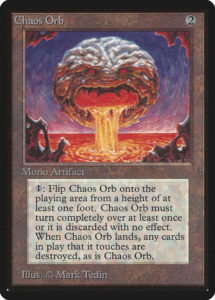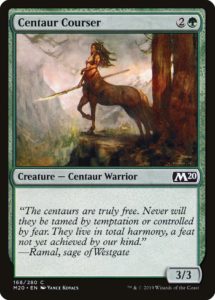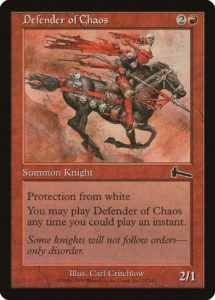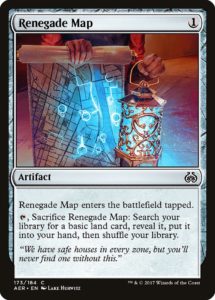Mystery Boosters are coming to a local game store near you in March, but folks attending PAX Unplugged (like me!) or 2020 MagicFests can crack these even sooner. While many folks are most excited about the many reprints or kvelling about the Convention Edition’s awesome playtest cards, many of us are most eager to dive into a wild, new Limited format. Mystery Boosters draw from a card pool more than a thousand cards larger than any other set in history. How does one even go about drafting such a format?
That’s our topic for the day, and while Chaos Draft is the clear starting place, there’s more to Mystery Boosters than meet the eye.
Order From Chaos
Of course, the obvious comparison for Mystery Booster draft is chaos draft. Mystery Boosters are designed to mimic the experience of a chaos draft. However, not everyone is an expert at chaos draft strategies or even necessarily agrees as to what constitutes a proper chaos draft. The rule of thumb is that chaos drafts utilize a wide variety of boosters; they eschew the intentionality behind crafted Limited environments for the adventure of making absurd combinations of cards.
However, there’s plenty of variety within the chaotic variance of chaos drafting. Your experience will be very different when you combine products from across Magic’s three decades of history than if you mostly stick to contemporary boosters (which tend to be cheaper). Sets like Fallen Empires or Alliances with their nonstandard pack size and not being designed for Limited play can make for subpar experiences for some; while others will revel in the absurdity, history, or combo potential. Some prefer more regularity to their chaos, such as everyone getting a Masters booster—so everyone gets to crack an exciting and powerful pack—while others believe that the ideal chaos draft is one where every no two packs at the table are the same.
Regardless of the spread of boosters, much of the joy of chaos drafting is discovery (and rediscovery). Players will discover new combinations of cards that might have never been played alongside each other, or quirky interactions only seen in Commander games, combine two very disparate tribal cards, or have ridiculous experiences. The last chaos game I watched involved a player with white, blue, black, and red mana having their mana “fixed” via a discard spell cheating their Obstinate Baloth into play.
As for strategy, chaos draft is strongly akin to many core set drafts, where the absence of overt themes encourages drafting fundamentals like B.R.E.A.D. (Bombs, Removal, and Evasion. A and D mean different things to different people.) The general absence of synergistic aggro decks makes it easier for board stalls to occur, and board stalls make evasive creatures and card advantage more powerful than they normally are (and they tend to be good in all but the fastest formats). These are good rules of thumb for chaos draft and they should serve you reasonably well at a Mystery Booster draft.
A Changed Chaos
Mystery Boosters pull from all over Magic’s history, but the majority of cards are more recent. This highlights how the rules of Chaos Draft have subtly shifted with Play Design paradigms. For much of Magic’s history, creatures were fairly weak and removal spells were quite strong. Synergy could overcome this imbalance, but it was often easy in a Chaos Draft for Giant Spider to answer 75% of an opponent’s creatures, demanding a removal spell despite it not being able to win the game by itself.
Creatures (especially common creatures) have received substantial buffs over the past decade. Once upon a time, only white and green got Grizzly Bears at common, and the past seven years have seen a corresponding decline in the power of removal (especially common removal). This had led to several Limited formats where interaction was so weak and creatures were so strong that it was often better to race an opponent than to try and kill or block their creatures (Avacyn Restored, Kaladesh, Amonkhet, and Ixalan are all excellent examples).
This changes the calculus that many chaos drafters of old are familiar with. It’s much easier to draft aggressive decks and break through board stalls than it used to be (and consequently, more difficult for control or evasive decks to force a board stall). In this vein, while removal remains extremely valuable, there are enough powerful thee drop creatures that five-mana removal spells aren’t quite that stellar (unless they provide additional advantage like Hypothesizzle or Deadly Visit).
Controlled Chaos
If you’ve been doing plenty of chaos drafts lately, you likely already know much of what’s been said. However, Mystery Boosters change the formula by being curated.
Mystery Boosters contain niche cards and weak cards just like any Magic product. They contain a variety of archetypes that might have scant support due to the pack distributions and the sheer size of the card pool, such as Allies, lifegain, artifacts-matter, and Madness. However, the set is mostly scoured of parasitic cards that would do literally nothing, like Foul Emissary, Whispering Snitch, and Vizier of the Anointed. Sure, folks are probably not playing Blessing of Belzenlok or God-Pharaoh’s Faithful, but that’s very different from a Corpse Cur with zero cards that it could ever recur. There will be plenty of cards that might not be supported in a given draft, but there are almost no Broodstars (cards that are normally awesome but utterly abysmal in chaos draft).
The result of this curation is that packs should contain, on average, more playable cards. Players will more often complete drafts having to cut cards from their deck rather than scrape together playables. This will force players to stretch their manabases less (since you can get enough playables in two colors), enable more speculative draft picks (since packs don’t dry up once they’re missing 4-5 cards), and allow players to chase weirder synergies rather than just take well-statted creatures and mediocre removal. For many, this will likely be an improvement upon chaos draft, since you’re less likely to end up with a pile of awful cards. For some, this might undercut the charm and discovery of the set. But to all these voices I say, play with the set and see for yourself.
But where’s the draft guide?
With 1,694 cards, there is simply too much variance to come up with a list of possible pick orders or for folks to remember them. There are definitely some cards that are high picks: Treasure Cruise, Renegade Map, Brimstone Mage, and Dismember, and Swords to Plowshares are all exceptionally powerful. Given how cards are distributed, it looks like they’ll show up at the same frequency as any other card. But again, this distribution makes it so the odds of any particular card even being opened at a draft are low. So instead of looking to draft specific cards, you should follow several rules of thumb.
Normal drafting rules still apply! As always, draft bombs. You want cards that can take over the game single-handedly. When synergy is sparse, raw power often carries the day. Lingering Souls, Imperious Perfect, and Dragonlord Ojutai can turn a disadvantage into overwhelming victory, so you should prioritize them over everything else. Similarly, draft removal, draft fixing (especially low-cost fixing like Renegade Map and Evolving Wilds) if you want to splash or play 3+ colors.
Mana sinks are key. A nontrivial amount of Limited involves board stalls. Having cards that provide a use for excess mana can help you outgrind your opponents without having expensive cards rot in your hand at the early game, or turn cheap cards into relevant draws in the late game. Awaken, Kicker, and Cycling are three excellent mana sink mechanics you should be looking for.
Do some research! I love knowing cards. I probably know at least half of all Magic cards at least by sight (if not by memory or name). And I still need a refresher when chaos drafting and to reread cards when playing Throne of Eldraine. There are a ton of mechanics in Mystery Boosters and nearly endless possible interactions between cards. While the set spoiler might be too much to digest at once, just perusing it or researching mechanics you might not be familiar with (like how Flip works on Jushi Apprentice) will make drafting a lot less overwhelming.
Review your assumptions. It’s fun during chaos draft to see a card you’ve drafted with before and remember how it used to be. However, there’s a double edge to this memory: sometimes your past experiences will lead you astray. Mirrodin block drafters players knew that Shatter was better than Terror, but know better than to make that same evaluation in Mystery Boosters. And sometimes previously unplayable cards might be worth a second look. For example, Dukhara Scavenger was all but unplayable in Amonkhet—it’s probably still not that good, but in a slower format, a 4/6 that draws the best threat from your graveyard could well be worth putting in your deck.
Have fun! Mystery boosters are designed more for fun and enjoyment than the more cutthroat supplement sets like Ultimate Masters (which, while awesome, was defined by a high price point the and drive to win a pod to get the Box Topper). While there is plenty of Spike-friendly Magic to be had, remember that many of your opponents might be more excited about ridiculous card interactions or absurd board states than they are about winning. That shouldn’t change what you do to enjoy yourself, but keep in mind that the attitude of the average table will likely be more relaxed than at a PTQ.
Take Skullclamp. Seriously. It’s one of the most broken cards of all time and if you have the chance to try it, you absolutely should give it a spin.
—Zachary Barash is a New York City-based game designer and the commissioner of Team Draft League. He designs for Kingdom Death: Monster, has a Game Design MFA from the NYU Game Center, and does freelance game design. When the stars align, he streams Magic (but the stars align way less often than he’d like).





